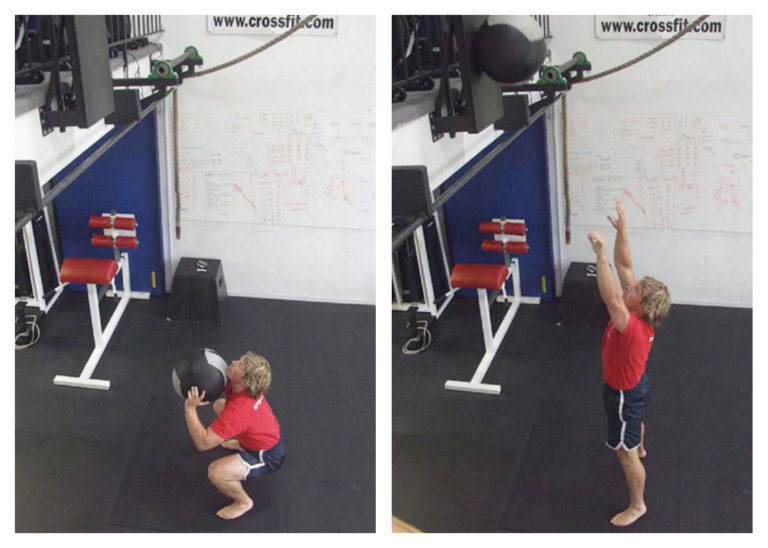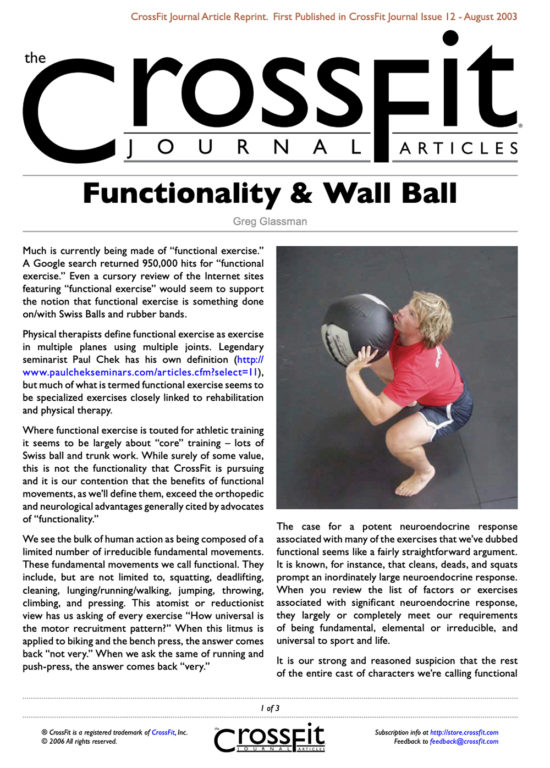Published August, 2003, in the CrossFit Journal. Download Original.
Much is currently being made of “functional exercise.” A Google search returned 950,000 hits for “functional exercise.” Even a cursory review of the Internet sites featuring “functional exercise” would seem to support the notion that functional exercise is something done on/with Swiss Balls and rubber bands.
Physical therapists define functional exercise as exercise in multiple planes using multiple joints. Legendary seminarist Paul Chek has his own definition, but much of what is termed functional exercise seems to be specialized exercises closely linked to rehabilitation and physical therapy.
Where functional exercise is touted for athletic training it seems to be largely about “core” training – lots of Swiss ball and trunk work. While surely of some value, this is not the functionality that CrossFit is pursuing and it is our contention that the benefits of functional movements, as we’ll define them, exceed the orthopedic and neurological advantages generally cited by advocates of “functionality.”
We see the bulk of human action as being composed of a limited number of irreducible fundamental movements. These fundamental movements we call functional. They include, but are not limited to, squatting, deadlifting, cleaning, lunging/running/walking, jumping, throwing, climbing, and pressing. This atomist or reductionist view has us asking of every exercise “How universal is the motor recruitment pattern?” When this litmus is applied to biking and the bench press, the answer comes back “not very.” When we ask the same of running and push-press, the answer comes back “very.”
The case for a potent neuroendocrine response associated with many of the exercises that we’ve dubbed functional seems like a fairly straightforward argument. It is known, for instance, that cleans, deads, and squats prompt an inordinately large neuroendocrine response. When you review the list of factors or exercises associated with significant neuroendocrine response, they largely or completely meet our requirements of being fundamental, elemental or irreducible, and universal to sport and life.
It is our strong and reasoned suspicion that the rest of the entire cast of characters we’re calling functional will eventually be demonstrated to be responsible for evoking a significant neuroendocrine response. That is, we contend that the pull-up, dip, box jump, running and the like, used in the manner in which we use them, are making large systemic contributions to overall fitness. This view, while novel, if not revolutionary, takes a back seat to a second CrossFit suspicion that is truly revolutionary.
We have come to believe that the specificity of cardiorespiratory training adaptations to exercise modality is a function of an exercise’s lack of functionality. This suggests three things. One, a more functional training modality will offer a greater cardiorespiratory benefit than a less functional modality. Two, a regimen of functional movements, developed across all three metabolic pathways, develops cardiorespiratory fitness with greater application to a larger number of activities, which implies the third, that there are varying qualities of cardiovascular fitness.
Currently we see each major functional movement carrying with it a cardiorespiratory capacity that can be developed independently and in conjunction with other functional movements to provide a superior cardiorespiratory response. We base this view on two commonplace observations in our clinical work.
First, elite runners, cyclists, swimmers, or triathletes crumble when exposed to simple CrossFit-like stressors and their failure is obviously cardiorespiratory. Second, our athletes are increasingly doing very well in competitions based on skills and activities for which they’ve little or no training.
Run, press, jump, throw, squat, deadlift, lunge, climb, and clean in all three metabolic pathways in varying combinations, at high intensity, and you’ll be at most several weeks out from good to great performance (strength and conditioning wise) for nearly any sport or activity.
The claim here is that regimens like our WOD are ultimately a better cardiorespiratory prep than cycling or running for any sport except cycling or running. In fact, the advantage extends to all ten general physical adaptations (cardiorespiratory endurance, stamina, strength, power, speed, flexibility, agility, accuracy, balance, and coordination).
The cardiorespiratory benefit of mixed modal, high-intensity functional movements, a la CrossFit’s WOD, is a better, more useful, broader cardiovascular stimulus than any monostructural activity like biking, swimming, or running—even in combinations.
The clear implication in light of our view of athletic training and more conventional practices is that the most efficacious tools available for metabolic conditioning are not generally employed. Until training regimens incorporate traditional resistance training protocols (weightlifting and gymnastics/calisthenics) to replace or supplement traditional “cardio” modalities (bike, run, swim, etc.), athletic conditioning remains inferior.
As an example of high functionality and marked carryover of cardiorespiratory benefit to sport and human performance in general, we offer our “wallball” exercise. This exercise is largely a front squat and push-press combination. The functionality of throwing or shooting an object from overhead and standing up is hopefully obvious.

We use a 20-pound Dynamax Medicine Ball and a flat vertical target (originally the wall and hence the name) located about 8-10 feet above the ground.
The movement begins as a front squat and follows through to a push press/shove that sends the ball up and forward to the target from which it rebounds back to the throwers outstretched arms where it is “absorbed” back into the squat. In its entirety the wall-ball is quite simply a throw.
When perfected, each shot looks identical to the one before, and the ball’s contact and departure are gentle and smooth. If the athlete endeavors to quiet the drill, the benefit to mechanics and breathing technique are immense.
The drill can be made as difficult as needed by increasing the weight of the ball, moving back from the target, or raising the target.
Start and see how long you can continue hitting these milestones:
30 seconds: 12 shots
1 minute: 25 shots
1 1⁄2 minutes: 37 shots
2 minutes: 50 shots
2 1⁄2 minutes: 62 shots
3 minutes: 75 shots
3 1⁄2 minutes: 87 shots
4 minutes: 100 shots
4 1⁄2 minutes: 112 shots
5 minutes: 125 shots
5 1⁄2 minutes: 137 shots
6 minutes: 150 shots
On failure (falling behind), rest and try again. Over time you want to get where you can do 150 shots in 6 minutes or less.
Our best time for 150 shots at a target 10 feet high with a 20-pound ball belongs to Mike Weaver at 4:52.
If you have the resources it might be best to master the drill (6 minutes/150 squats) with the 4-pound ball and work your way up to the 20-pound ball. (Dynamax has balls at 4, 6, 8, 10, 12, 14, 16, 18, and 20 pounds.)
Here are technique fundamentals:
- Each rep begins with a rock bottom squat, with feet flat on the floor
- Keep the elbows down and in
- Keep the ball low to the chest
- Don’t let the ball obstruct view of target
- Launch with little finger roll and push
- Make ascending and descending movements the same
- Minimize breathing and ball contact noise
- Breath deeply and attempt to synchronize breathing to shot rate
The wall-ball drill comprises two highly functional classical weightlifting movements brought together at light loads and extended duration to create a super-potent metabolic conditioning tool with an enormous potential for increasing athletic performance.

Functionality and Wall Ball